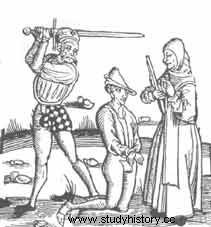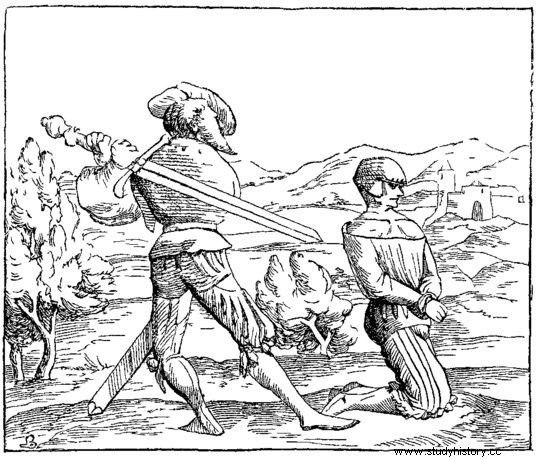People were probably not much worse than they are today, but they certainly weren't better either. This is clearly seen in the crimes committed in past centuries. For example, rape was a real plague in modern Krakow.
It was a widespread crime, but also very severely punished - if the guilt was proved the perpetrator could even be killed . Of course, only a small percentage of rapes were reported to the authorities.
The servants most exposed to sexual violence were condemned to the grace and disfavor of their employers. It often happened that the master of the house came back drunk in the evening and in the absence of his spouse (or literally under her nose!) he vented his desires with a girl working in the kitchen or cleaning. Many of the victims were still underage. Some could even be said to be children.

Execution of a young man. Could it be for the rape of an innocent woman?
Jan Kracik and Michał Rożek - authors of the book "Hultaje, villains and harlots in old Krakow" - cite a number of examples taken from court books. In 1776 a certain Mateusz Lubowski seduced the young servant Teresa. The same thing happened in 1689 with Agnieszka Jaroszanka. In 1684, in turn, a certain Sebastian Drózd raped a minor girl, Justyna from Krzeszowice. Her mother testified: He pulled her down into the pit, made her slowly (p. 136) .
A certain Regina from Mysłowice, battered in 1721, was returning to the court herself to the tragic night:
On Sunday evening I was in the kitchen, I turned the roasts, then the gentleman came, took me by the hand and led me to the kitchen bed (...) I called, he said, not like me here he had girls, and they didn't call out, then he came to me a second time (...), did that again and I cried because I was in pain (p. 137).

The penalty for rape was death
The authors of "Scavengers, villains and harlots ..." write that the accusers did not always demand the highest penalty. Many of the women did not care much. They only wanted compensation in money: In 1592 master tailor Sebastian Boduszkiewicz accused his journeyman Stanisław of raping his sister, demanding one hundred fines of compensation, a fairly high sum (p. 137) .
In addition to dozens of rapes similar to those described above, there have also been particularly violent cases. The case of Susanna Moskovskaya literally chills the blood in my veins. In 1589, three men took her to a fire after the city walls. There, all three of them - Jakub Folga, Bartosz France and Jędrzej Brabik - gang raped her . As punishment, they put their heads under the executioner's sword (p. 136).

But things did not always end this way. If the rapist was a high-ranking townsperson or even a city servant, he did not have to fear for his life. For example, when in 1613 a Krakow executioner raped a girl , she only received a small allowance in return. In many cases, rapists were acquitted because examination by special experts (usually midwives) did not prove anything. Women who had not been virgins before the rape were all the more losing.
Finally, it is worth checking what the Church has to offer. Well, he fought rape quite vigorously. Only that not because of the fate of the aggrieved or the sinfulness of the act itself. Most of the clergy feared that rape was a sure path to debauchery . Obviously, the debauchery of abused women. Well, what times, this way of thinking ...
Source:
- Jan Kracik, Michał Rożek, Hultaje, villains, harlots in old Krakow , Petrus, 2010, pp. 136-139.
